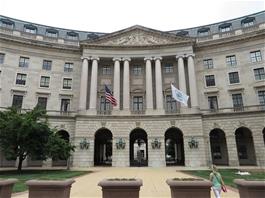Clean Water Current
NACWA Talks Compliance Assistance with Head of EPA Enforcement
 (October 16, 2018) - NACWA met with Assistant Administrator Susan Bodine, head of EPA’s Office of Enforcement and Compliance Assurance (OECA), on October 9 to discuss how NACWA members can best work with OECA to accomplish the shared goal of protecting water quality.
(October 16, 2018) - NACWA met with Assistant Administrator Susan Bodine, head of EPA’s Office of Enforcement and Compliance Assurance (OECA), on October 9 to discuss how NACWA members can best work with OECA to accomplish the shared goal of protecting water quality.
In an August 2018 memo to EPA Regional Administrators, Ms. Bodine announced that EPA will change the name of its priorities from “National Enforcement Initiatives” to “National Compliance Initiatives” to better convey the message that increased compliance is the goal, and that enforcement actions are not the only tool for achieving this goal. This change echoes calls from NACWA for a “compliance assistance first” approach by EPA in appropriate circumstances. The Association applauds this move by the Agency.
Ms. Bodine understands that to continue to make the kind of environmental progress that justifies large infrastructure expenditures from NACWA’s members, compliance assistance can be a more effective approach for new instances of noncompliance and for communities already under long-term enforcement actions.
NACWA expressed its belief that EPA should not only be open to modification of decrees, but should also encourage modification where the utility/community can demonstrate that the change will result in increased net environmental benefits and/or more responsible and affordable approaches to achieve Clean Water Act (CWA) compliance. However, Ms. Bodine made it clear that utilities must come into those negotiations prepared with adequate justification and assurance that changes will comply with CWA requirements.
Ms. Bodine also understands the importance of addressing regional enforcement inconsistencies, acknowledging that policy, and not personalities, should play the leading role in the final terms of enforcement matters of this magnitude.
NACWA thanks Ms. Bodine for her leadership on these important issues and is optimistic the Association can continue to advance a more coordinated and collaborative relationship with EPA in the enforcement realm.